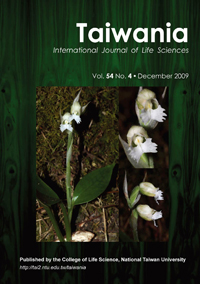Research Paper
Effect of Cu and Cd on Oxidative Enzymes and Chlorophyll Content of Moss Racomitrium crispulum
Dinesh Kumar Saxena, Md. Saiful-Arfeen
Published on: 30 November 2009
Page: 365 - 374
DOI: 10.6165/tai.2009.54(4).365
Abstract
Present study was carried out to evaluate antioxidant, photosynthetic and productivity of moss Racomitrium crispulum (Hook. f. et Wils.) Hook. f. et Wils. under various phytotoxic concentration of metals Cu and Cd for different days. Exogenous supplied Cu and Cd to R. crispulum significantly give stress on oxidative enzymes as well as on photosynthesis. After 15 days of treatment, the maximum decrease in NRA were 27% and 47% at 0.2 M concentration both in Cu and Cd treated moss is concomitant with the decrease in percent nitrogen and protein of the respective samples. A significant degradation of chlorophyll was 28% at 0.1 M Cd after 15 days. Increase in carotenoid content was noticed at low concentration of metals (0.01 M) attributed to photoprotective role of them. Carbohydrate content decreases 54% and 57% of Cu and Cd treated moss after 15 days showed their deleterious effect only after prolong period of incubation. Total sugar content is in inverse of carbohydrate to compensate the moss physiology. Peroxidase activity increased with the increase in treatment concentration, while it decreases with respect to increase in exposure time. The maximum peroxidase activity was observed is 11% at 10 mM treatment in 6 days Cu treated sample. The increase in SOD activity was observed under higher concentration and also concomitant with respect to increase in incubation period under both metal (Cu and Cd). Our findings and those of other cited herein suggested that under mild to moderate metal (Cu and Cd) stress for prolong period give inductive effect and also on photosynthates of moss R. crispulum. This further suggests that under every possible alteration, cell maintains their integrity and homeostasis by shuffling their metabolic and physiological responses. Present finding recommends that R. crispulum of Kumaon hills (India) is tolerant to Cu and Cd metal pollution and can be use as bioaccumulators for these two metals.
中文摘要
本報告主要是使用不同濃度的銅及鎘處理蘚類植物Racomitrim crispulum,經一段時間後評估其對植物抗氧化劑,光合能力及產量的影響。R. crispulum 處理銅及鎘後對其氧化酵素及光合作用都有顯著的抑制作用。分別使用 0.2 M 的銅及鎘處理15 天後,硝酸還原酵素活性分別減少27% 及47%,氮及蛋白質含量同時也減少。使用0.1 M 鎘處理15 天後,葉綠素明顯分解而減少,但是低濃度的金屬(0.01 M)處理,具有光保護功能的類胡蘿蔔素含量顯者增加。分別使用銅及鎘處理植物15 天後,碳水化合物含量分別減少54% 及57%,此結果表示長時間的處理之後,金屬對植物的害處才能顯现出來。總糖量與碳水化合物含量呈反比關係,這是蘚類植物的補償生理作用。過氧化氫酶活性隨着處理金屬濃度提高而增加,但是隨着處理時間的延長而減少。使用10 mM銅處理植物6 天其過氧化氫酶活性可達到最高。超氧物歧酶 (SOD) 活性隨着處理金屬濃度的提高及處理時間的延長而增加。本研究及參考文献都發現長時間的低等程度及中等程度的金屬逆境,對R. crispulum 植物的氧化酵素及光合產物都有誘導作用。此結果顯示,植物處於每一種處理交替作用情况下,能够調整它們的新陳代謝作甪及生理反應,以維持細胞的完整性及恆定性。綜合本研究結論是R. crispulum 對銅及鎘的金屬汙染具有耐性,因此能够作為此兩種金屬的累積植物。
Keyword: Phytotoxic metals Cu and Cd, Moss Racomitrium crispulum, Oxidative enzymes, Photsynthates, Productivity response. 植物毒害金屬銅及鎘、蘚類植物Racomitrim crispulum、氧化酵素、光合產物、產量回應。


